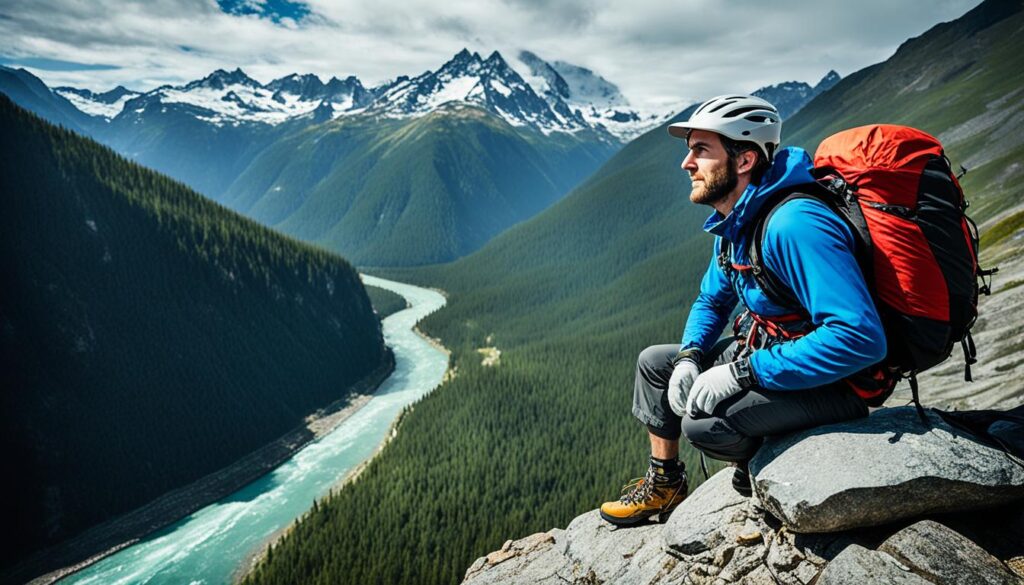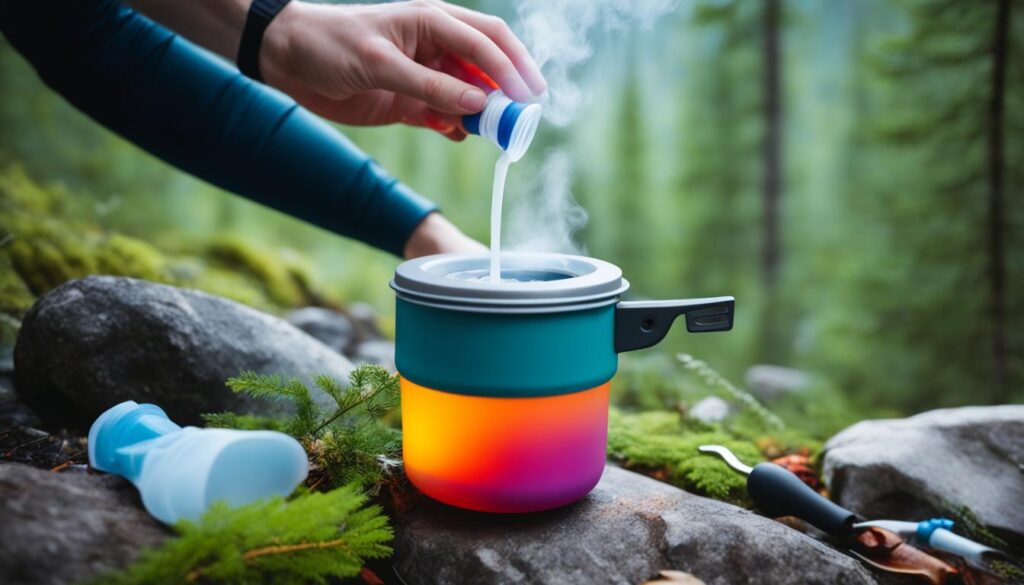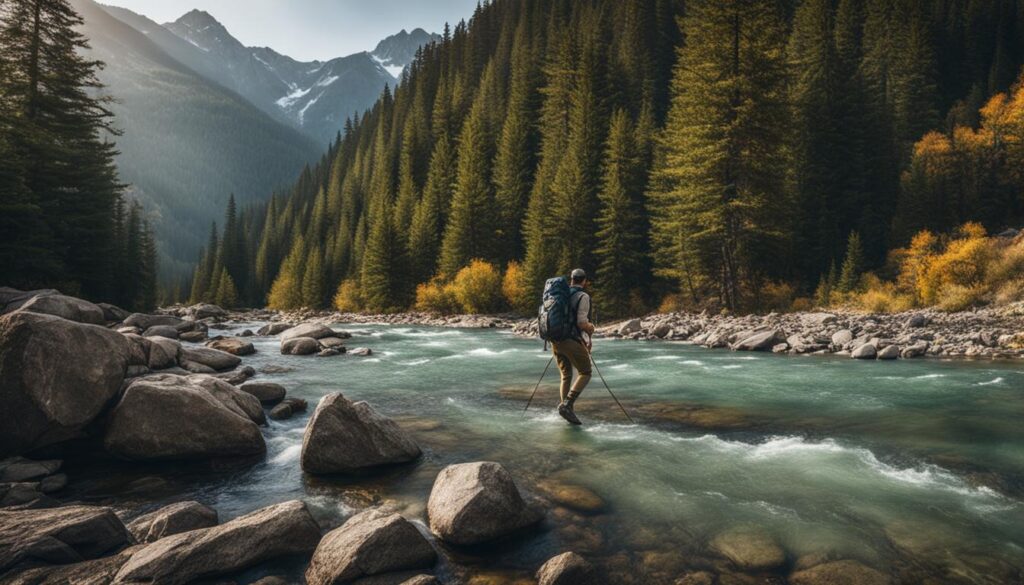Backpacking Safety: Staying Secure on the Trail

Backpacking travel is an exciting adventure that allows you to immerse yourself in the beauty of the great outdoors. Whether you are hiking through serene forests or conquering challenging mountain trails, backpacking offers a unique sense of freedom and connection with nature.
While backpacking is generally safe, it’s important to prioritize your safety on the trail. This guide is specifically designed for women who are considering backpacking, whether solo or in a group. We will discuss essential safety tips, what to pack for your trip, hygiene considerations, and more.
Key Takeaways:
- Prioritize safety while backpacking to ensure a secure and enjoyable trip.
- Consider the specific needs of women when planning your backpacking adventure.
- Pack the right gear and clothing to stay comfortable and protected on the trail.
- Take proper precautions for personal hygiene, including periods and feminine hygiene.
- Follow safety guidelines and be aware of potential risks in the backcountry.
What to Pack for Your Trip
Having the right clothing is crucial for an enjoyable backpacking trip. Whether you’re heading out for a weekend hike or embarking on a multi-day expedition, being prepared with the right gear will enhance your experience. Here are some essential items to pack for your backpacking adventure:
Clothing
Outer layers should be both water-resistant and breathable to protect you from the elements while allowing perspiration to escape. Look for jackets made from materials like Gore-Tex or nylon.
Your base layers are the foundation of your clothing system. Choose lightweight and moisture-wicking materials like polyester or light wool to keep you dry and warm, even if you sweat.
To stay comfortable and prevent discomfort, invest in quick-drying underwear. This will help prevent yeast buildup and reduce the risk of urinary tract infections (UTIs).
Sports bras are an essential item for any backpacking trip. Choose ones that are comfortable, supportive, and able to withstand the rigors of the trail.
Don’t forget about your feet! Long hiking socks are a must-have item to protect against bugs, thorns, and other trail hazards. Look for ones made from materials like merino wool for optimum comfort and durability.
Lastly, make sure to invest in waterproof footwear with solid grip. Whether you prefer hiking boots or trail running shoes, choose footwear that provides traction and stability on rough and varied terrain.
Packing Checklist
Being organized and having a checklist will ensure you don’t forget any important items. Use the following list to help you pack for your backpacking trip:
- Backpack
- Tent
- Sleeping bag
- Sleeping pad
- Cooking equipment (stove, pots, utensils)
- Water filter or purification tablets
- Lightweight, nutritious food
- Map and compass
- First aid kit
- Headlamp or flashlight
- Multi-tool or knife
- Firestarter (matches, lighter)
- Sunscreen and insect repellent
- Toiletries (toothbrush, toothpaste, biodegradable soap)
- Personal items (medication, glasses)
- Trash bags and ziplock bags
Additional Tips
Remember to pack lightweight and compact items to minimize the weight of your backpack. Opt for multi-purpose gear whenever possible, and consider the weather conditions and duration of your trip when deciding what to pack. It’s always better to be overprepared than underprepared when it comes to backpacking.
With the right clothing and gear, you’ll be well-equipped for your backpacking adventure. Stay tuned for the next section, where we will discuss essential gear for your trip. Happy backpacking!
Gear
When it comes to backpacking, having the right gear can make all the difference in ensuring a comfortable and enjoyable trip. From choosing the right backpack to packing essential items like a sleeping bag and tent, each piece of gear plays a crucial role in your backpacking experience. Here are some key gear items to consider:
Backpack
A good backpack is the backbone of your backpacking adventure. Look for packs designed to fit women’s bodies, as they offer better comfort and support. Consider the size of the backpack based on the duration and intensity of your trip. Opt for a lightweight backpack that distributes the weight evenly and has enough compartments for efficient organization.
Backpacking Tent
Your choice of tent can greatly impact your camping experience. Lightweight backpacking tents are designed to withstand various weather conditions while minimizing the weight you carry. For most trips, a 3-season tent will suffice. However, if you plan on winter backpacking, a 4-season tent is necessary to withstand harsher elements.
Sleeping Bag
When it comes to a good night’s sleep in the wilderness, a quality sleeping bag is essential. Look for a sleeping bag that provides proper insulation and warmth for the expected weather conditions. Ensure that it is lightweight and can be compactly packed, saving space in your backpack.
Sleeping Pad
Pair your sleeping bag with a comfortable sleeping pad that offers insulation and cushioning. Inflatable sleeping pads are a popular choice as they provide both comfort and insulation from the cold ground. Look for a sleeping pad that is lightweight and easily packable to minimize the weight in your backpack.
Lantern
Don’t leave yourself in the dark. A portable lantern is an essential item for backpacking trips, providing necessary lighting during the night. Opt for a lantern that is compact, lightweight, and has a long battery life to ensure you have enough light to navigate around your campsite.
With the right gear, you’ll be prepared to tackle any backpacking adventure with confidence. Take the time to research and invest in quality gear that suits your needs and the expected conditions of your trip.
Food and Hydration
When embarking on a backpacking trip, it’s crucial to pack enough food and water to sustain your energy and stay hydrated throughout your journey. To ensure you have a sufficient food supply, a basic rule of thumb is to pack around two pounds of food per day. This will provide you with the necessary calories and nutrients needed for the physical demands of backpacking.
Consider packing multivitamins to supplement your diet and make up for any potential nutrient deficiencies. These compact and lightweight supplements can help prevent fatigue and keep your body functioning optimally while on the trail.
Staying properly hydrated is equally important. Carrying a reliable water filter allows you to safely drink from any water source you encounter along the way. This saves you from having to rely solely on carrying large quantities of water, which can add unnecessary weight to your pack. A water filter ensures you have access to clean and safe drinking water throughout your backpacking adventure.
When it comes to cooking your meals, having the right backpacking cookware is essential. A boiling cup, backpacking stove, and spoon are the basic items you’ll need to prepare simple and delicious meals on the trail. Opt for lightweight and durable cookware that can withstand the rigors of backpacking. This will make cooking a breeze and lighten your load.
Here’s an overview of the essential backpacking cookware:
| Item | Description |
|---|---|
| Boiling Cup | A compact and lightweight cup that is perfect for boiling water and cooking meals. |
| Backpacking Stove | A portable stove designed for backpacking that allows you to cook meals efficiently. |
| Spoon | A sturdy and lightweight spoon for stirring and enjoying your backpacking meals. |
Remember to pack these essential items for food and hydration to ensure you have a nourishing and comfortable backpacking experience.
Hygiene
Taking care of personal hygiene is essential while backpacking. Whether you’re hiking for a few days or embarking on a longer adventure, maintaining cleanliness is crucial for your well-being on the trail. Here are some tips to help you maintain feminine hygiene and stay fresh during your backpacking journey.
Going to the Bathroom
When nature calls, it’s important to have a plan for peeing in the backcountry. Consider using a female urinal or bring a pee rag for convenience. Female urinals are designed specifically for women and allow for easy and hygienic peeing while standing up. Alternatively, a pee rag is a reusable cloth that you can use to wipe and dry yourself after peeing. Remember to dispose of any waste properly to minimize environmental impact.
Managing Your Period
Backpacking with your period doesn’t have to be a challenge. There are various feminine products available that are suitable for backpacking. You can choose to use menstrual cups, tampons, or pads based on your personal preference. Menstrual cups are an eco-friendly and reusable option that can last for years, making them ideal for long backpacking trips. Tampons and pads are also convenient and easy to pack. Remember to bring enough supplies to last you through your entire trip and pack them in a waterproof bag to keep them clean and dry.
Pack Feminine Wipes
Keeping yourself clean and fresh is important even when camping. Pack some feminine wipes to help you stay hygienic throughout your backpacking journey. Feminine wipes are gentle on the skin and can be used for general cleaning and freshening up. They are compact and lightweight, making them easy to carry in your backpack. Use these wipes to clean your hands, face, or any other areas that require a quick freshening up.

Staying Safe on the Trail
When it comes to backpacking solo, safety should always be a top priority. While backpacking can be a safe and rewarding experience for women, it’s important to take precautions, especially when venturing into the backcountry alone. While solo backpacking is not without risks, incidents are rare, and data actually shows that crimes in national parks are significantly lower than outside of them.
However, it’s crucial to be aware that women may generally be less safe when alone in the backcountry. To help ensure your safety, it’s advisable to take the same precautions you would in a large city. By staying prepared and following some simple guidelines, you can minimize the risks and enjoy your backpacking adventure with peace of mind.
Stay Prepared and Be Aware
Here are some essential safety tips to keep in mind:
- Research and plan your route in advance, familiarizing yourself with the trail and its potential hazards.
- Share your itinerary and estimated return time with a trusted friend or family member.
- Carry maps, navigational tools, and a compass or GPS device to avoid getting lost.
- Be mindful of wildlife encounters and understand how to respond appropriately.
Stay Connected
While the backcountry offers a chance to disconnect from technology, it’s important to have a reliable means of communication in case of emergencies. Consider carrying a cell phone, satellite communicator, or personal locator beacon (PLB) to summon help if necessary.
Trust Your Instincts
Listen to your gut instincts. If something feels off or unsafe, trust yourself and make decisions accordingly. It’s better to err on the side of caution than to risk your safety.
“Remember, safety first. Be prepared, stay alert, and trust yourself.”
By following these guidelines and using common sense, you can stay safe on the trail during your solo backpacking journey. Remember, incorporating safety measures into your trip planning is an important part of enjoying a worry-free adventure.
Next, we’ll share six valuable tips for staying safe on the trail. These tips are applicable to both solo backpacking and group backpacking situations, so be sure to read on for important insights.
6 Tips for Staying Safe on the Trail
When embarking on a backpacking adventure, it’s crucial to prioritize safety. Follow these six tips to ensure a secure and enjoyable experience:
- Carry Bear Spray: Bears and other wildlife can pose a threat in certain areas. Be prepared by carrying bear spray to deter any potential encounters.
- Pack a Comprehensive First-Aid Kit: Accidents can happen on the trail. Always carry a well-stocked first-aid kit that includes essentials like bandages, antiseptic wipes, and pain relievers.
- Wildlife-Proof Your Food: To protect both yourself and the wildlife, store your food properly. Hang it from a tree branch or use bear-resistant containers to prevent attracting animals.
- Always Carry a Map: Familiarize yourself with the trail beforehand and carry a detailed map. Make sure you know how to read it and use it effectively to navigate your way.
- Stay on Established Trails: Straying off the beaten path can increase the risk of getting lost or encountering hazardous terrain. Stick to established trails to minimize these risks.
- Be Cautious of Strangers and Consider Carrying Personal Defense Products: While most fellow hikers are friendly, it’s essential to use caution when interacting with strangers. Consider carrying personal defense products, such as a whistle or pepper spray, for added security.
Additionally, don’t forget to pack extra layers and be prepared for changing weather conditions. Always have an emergency plan in place in case of unforeseen circumstances.

| Tips for Staying Safe on the Trail: |
|---|
| 1. Carry Bear Spray |
| 2. Pack a Comprehensive First-Aid Kit |
| 3. Wildlife-Proof Your Food |
| 4. Always Carry a Map |
| 5. Stay on Established Trails |
| 6. Be Cautious of Strangers and Consider Carrying Personal Defense Products |
Know Your Limits: Physical Conditioning for Backpacking
When it comes to backcountry hiking, physical conditioning plays a crucial role in ensuring a safe and enjoyable experience. Proper fitness and training can greatly enhance your endurance, strength, and overall performance on the trail.
One of the best exercises for physical conditioning in backpacking is regular running. Running helps strengthen your leg muscles, hips, and core, which are all essential for navigating the rugged terrain during your hikes. Additionally, it improves cardiovascular fitness, allowing you to sustain longer periods of physical activity without getting easily fatigued.
Endurance and stamina are key attributes necessary for long hikes. As you gradually increase your running distance and intensity, your body adapts to prolonged physical exertion, enabling you to hike for extended periods without feeling overly tired.
To ensure consistent progress in your physical fitness, it’s beneficial to follow a workout schedule. This can help you stay motivated and accountable to your training routine. Incorporate exercises that target different muscle groups, such as strength training for your upper body and core, to develop overall body strength and stability.
Remember, being in good physical shape not only enhances your performance but also reduces the risk of exhaustion and injury on the trail. Don’t push yourself too hard too quickly; gradually build your fitness level and allow your body to adapt to the demands of backpacking.
Quick Tips for Physical Conditioning:
- Start with shorter runs and gradually increase the distance and intensity.
- Incorporate strength training exercises to build overall body strength.
- Include cardiovascular exercises other than running, such as cycling or swimming, to diversify your training regimen.
- Listen to your body and give yourself rest days to prevent overtraining and allow for recovery.
- Stay hydrated and maintain a balanced diet to support your physical fitness goals.
- Consult with a fitness professional or trainer for personalized guidance and assistance.
By prioritizing physical conditioning and incorporating a well-rounded workout routine into your lifestyle, you’ll be better equipped to conquer the challenges that come with backpacking. Remember, it’s always important to listen to your body and know your limits, pushing yourself safely within those boundaries to ensure an enjoyable and rewarding backpacking experience.
Conclusion
Backpacking safety is an essential aspect of any trip, ensuring that you can fully enjoy your backpacking travel experience while staying secure on the trail. By taking the necessary precautions and being prepared, you can minimize risks and maximize your enjoyment.
First and foremost, make sure you pack the right gear for your backpacking adventure. From clothing and footwear to backpacks and tents, having the appropriate equipment is crucial for your safety and comfort in the backcountry.
Additionally, maintaining personal hygiene is important while backpacking. Whether it’s managing your period or practicing general hygiene, proper care ensures your well-being throughout the trip.
Lastly, staying physically fit and prioritizing safety are key components of backpacking safety. By being in good physical shape, you reduce the risk of exhaustion and injury on the trail. Always stay aware of your surroundings and follow safety guidelines to make the most of your backpacking experience.
Remember, when it comes to backpacking, safety should always be your top priority. So, pack smart, prepare well, and have a fantastic time exploring the great outdoors!
Source Links
- https://www.hykeandbyke.com/blogs/hyke-byke-blog/backpacking-for-women-6-tips-for-staying-safe-on-the-trail
- https://www.backpacker.com/survival/8-rules-for-staying-safe-in-the-backcountry/
- https://wanderlustphotosblog.com/2021/11/08/ten-easy-backpacking-safety-steps-to-make-backcountry-hiking-safer-and-more-enjoyable/